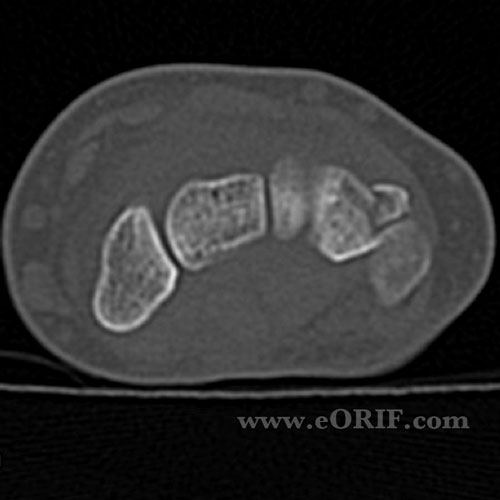|



|
synonyms:
Triquetral Fx ICD-10
A- initial encounter for closed fracture
B- initial encounter for open fracture
D- subsequent encounter for fracture with routine healing
G- subsequent encounter for fracture with delayed healing
K- subsequent encounter for fracture with nonunion
P- subsequent encounter for fracture with malunion
S- sequela
Triquetral Fx ICD-9
Triquetral Fx Etiology / Epidemiolgy / Natural History
- uncommon.
- May result from a direct blow to the dorsum of the hand or extreme dorsiflexion of the hand.
Triquetral Fx Anatomy
Triquetral Fx Clincal Evaluation
- tenderness and swelling in the wrist.
- Tenderness over the triquetrum. Triquetrum is palpated by radial deviation of the wrist which makes the triquetum accessible by moving it away from the ulnar styloid process.
Triquetral Fx Xray
- Standard P/A, lateral and oblique views of the wrist
- Consider getting comparison views of normal wrist, or CT scan if diagnosis is not definitive on plan films.
Triquetral Fx Classification/Treatment
- Chip fractures: 2-3 weeks of immobilization. Begin ROM exercises when symptoms permit.
- Body minimally displaced: cast immobilization for 4-6 weeks.
- Body displaced: closed reduction and percutaneous pinning or ORIF.
Trapzium Fracture Associated Injury / Differential Diagnosis
- Bennett's Fx
- Distal radius Fx
- Scaphoid Fx
Trapzium Fx Complications
- continued pain,
- Nonunion
- malunion
- post-traumatic arthritis
Trapzium Fx Follow-Up
- Post-Op: Place in volar splint. Encourage digital ROM, elevation.
- 7-10 Days: remove splint. Place in short arm thumb spica cast. Consider removable splint with gentle ROM if fixation was extremely secure.
- 6 Weeks: Cast removed. Check xrays. Started gentle ROM exercises. Activity modifications: no heavy manual labor, no contact sports, no lifting >5 lbs.
- 3 Months: Check xrays. If union is complete return to full activities.
Trapzium Fx References
|



